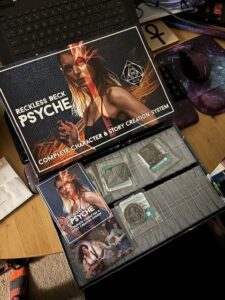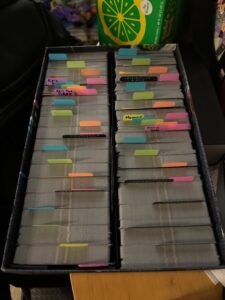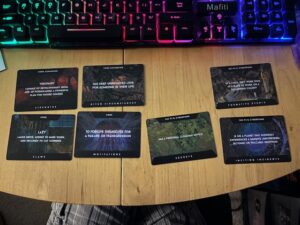Writing Tools: Reckless Deck: Psyche
 I’ve accumulated a large collection of card-based writing tools, each of which is useful to different parts of my writing process. So I’ve decided to do a series of posts about the various decks I own and how I use them in my writing.
I’ve accumulated a large collection of card-based writing tools, each of which is useful to different parts of my writing process. So I’ve decided to do a series of posts about the various decks I own and how I use them in my writing.
It’s been a while since I’ve gotten a new set of cards, but my order of Reckless Deck: Psyche arrived a couple of weeks ago! This set is meant to be a character generation system first and foremost, but alongside creating the character, you can also create a story plot. Now that I’ve had a chance to play around with it a bit, I’ve got some insight into how you might use this as a writing tool!
First of all, when I back a card-based writing tool, I back HARD. So yes, this is pretty much everything available when it first arrived. It’s nearly 2,000 cards between the Core set, Core Expansion set, seven genre-oriented expansions (Contemporary, Horror/Urban Fantasy, Lovecraftian/Noir, Steampunk/Victorian, Epic Fantasy, Sci-Fi/Cyberpunk, and Dystopian/Post-Apocalyptic) and two mini expansions (Epic Fantasy Dark and Fairy Tales/Folklore). It also came with a NICE playmat that didn’t make it into the photograph, which has boxes marked for each of the eight categories of cards.
The Core set and Core Expansion set come in four categories: Strengths, Flaws, Given Circumstances, and Motivations. Three of these are self-explanatory, and the fourth is fairly simple as well: Given Circumstances give you a problem that your character is facing. The expansions (Companion Decks and minis) include Occupation, Secrets, Formative Events, and Inciting Incidents.
 Because I’m a little bit fussy about organization (though Jeremy calls it ingenuity), I made additional dividers for the cards so I could keep the four categories for each set separate from each other. The big chunk on the bottom right of the box is the Core and Core Expansion divided into its four categories. Each of the genre expansions then has a card to show where it begins, and then the pink, orange, green, and blue tabs separate that genre’s four categories of cards.
Because I’m a little bit fussy about organization (though Jeremy calls it ingenuity), I made additional dividers for the cards so I could keep the four categories for each set separate from each other. The big chunk on the bottom right of the box is the Core and Core Expansion divided into its four categories. Each of the genre expansions then has a card to show where it begins, and then the pink, orange, green, and blue tabs separate that genre’s four categories of cards.
The cards all fit into the box, even with my added dividers, but after I took this photo, I pulled out the Fairy Tale/Folklore mini expansion to give the other cards a bit more freedom of movement, so I can draw straight from the box, rather than shuffling eight separate stacks of cards. (I do this with most of my card sets, though every once in a while, I’ll pull out categories to shuffle them to re-randomize the category.) I’ll find a small box for the Fairy Tale/Folklore cards, as I have a sneaking suspicion I may be using those more frequently, at least based on what I’ve been writing a lot lately.
But for my first character creation with this system, I used the Sci-Fi/Cyberpunk expansion to come up with an idea for a main character for a sci-fi piece I wanted to write.
 Although the set has eight categories of cards, I skipped the Occupation one for this draw because I already had a sense of who I wanted this character to be. However, that wound up changing as I worked out the details and realized the scope of my story.
Although the set has eight categories of cards, I skipped the Occupation one for this draw because I already had a sense of who I wanted this character to be. However, that wound up changing as I worked out the details and realized the scope of my story.
So from the seven drawn cards, my MC is a visionary who wants to change the way things work in the universe (anti-slavery, anti-capitalist) (Strength), but they lack the drive to get it done (the problem is big, and they don’t want to put in the work it would require, and/or they just don’t have the time or ability to do so) (Flaw). They’re also in love with someone else on the crew (Given Circumstance). They failed a previous partner, so they need to forgive themself for that before they can let that someone know (Motivation). They have a personal cloaking device (don’t know how that ties in, but it’ll work into the plot) (Secret), and as a child they were enslaved on a gas mining colony (gotta work this in, too) (Formative Event). The planet they’re on suddenly has a massive tectonic event, and they need to get themself out alive, but they also want to make sure their someone makes it (Inciting Incident).
My further brainstorming is that their childhood gives them knowledge to help them and the person they’re in love with to escape from a cave-in caused by the tectonic event. The authorities don’t want anyone to leave, but the MC can use their personal cloaking device to hide them and their someone if they get very close to one another, which leads to the revelation about being in love with that person. The strength and flaw will be within their general personality. And maybe the person they love sees them in a new light when they actually take initiative and get something done.
As I work through the ideas, I take them as possibilities. For example, the Given Circumstances card specifically says “unrequited love,” but I’m doing it more as a secret crush that will then get revealed in the course of the story.
So it winds up being 1) draw cards, see how they work together; 2) if something really doesn’t fit (original draw had the Given Circumstance being that they were a good swimmer, but that didn’t fit with the other cards), replace it until everything starts to mesh together, 3) keep iterating on the ideas presented until there’s a plot that works with this character.
The downside is that this was going to be a flash fiction piece, but after expanding the ideas from the cards and sketching out the plot, I’m pretty sure it’s going to be a short story. It also doesn’t quite mesh with the prompt I had going in, so I may need to do a simpler draw for the flash piece. As it is, I made one small tweak to the MC’s planned occupation, making them one of a crew of scavengers who lands on planets and sifts through ruins. Sort of space “grave robbers,” hopping across the universe in search of a big score they can sell at a profit.
In addition to using this set for character building, I could also see drawing from the Inciting Incident cards to some up with a quick randomly generated starting point for a piece in a specific genre. The Formative Events or Given Circumstance cards could also be used in a similar way, though all of these will likely need a bit more fleshing out, and since they’re from the Core sets, they don’t necessarily give you genre-related starting points.
While the characters can be used for fiction, I could also seeing this set being used for gaming characters, either to come up with a character if you don’t have any ideas, or for GMs to randomly generate some characteristics for an NPC they need to create on the fly.
The cards themselves are standard playing card sized, with the backs matching across all the cards, and each category having a themed background. Within the expansions, those themes coordinate with their genres. The tops of the cards tell you what set it comes from, and the bottom tells you its category. Handy for when you accidently dump about 1,000 cards on the floor and need to sort them … ask me how I know. They are a bit slippery straight out of the plastic, though I suspect they’ll get less so with time.
Kickstarter backers of this set are still receiving their rewards, but the creator is also selling the complete set online for North American addresses only. They will eventually be selling it in smaller pieces, in case you’re not prepared to dive as fully into this set as I was.
In summary, use Reckless Deck: Psyche for: character creation (writing or gaming), developing a plot for a story or longer, or just finding a random trait to add to a character to flesh them out.

Comments